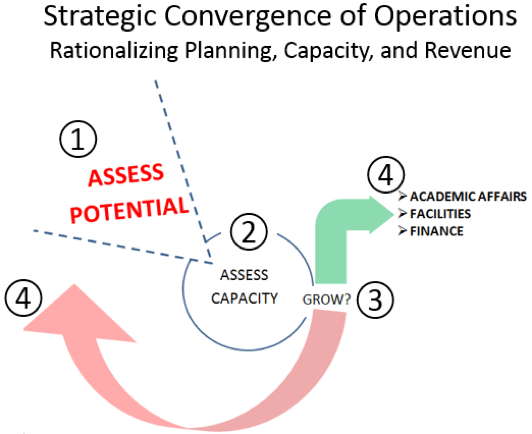Enrollment As a Lens on Higher Education
 If the days of being able to work decentrally are over and we cannot afford to do two or three or five separate tactics, then finding ways to optimize internal intelligence and collaboration are past due. Here are some fresh ways to get the individual things we do to achieve multiple goals. Higher education enrollment is a complex topic.
If the days of being able to work decentrally are over and we cannot afford to do two or three or five separate tactics, then finding ways to optimize internal intelligence and collaboration are past due. Here are some fresh ways to get the individual things we do to achieve multiple goals. Higher education enrollment is a complex topic.
Traditionally college enrollment has been viewed as 1) a raison d’etre (especially for undergraduate colleges) and 2) the primary source of operating revenue. We are a college for our students’ education and we can continue to be a college because of our students’ tuition and fees. But enrollment is more than that. Think about what enrollment represents.
Higher education enrollment success is all about what people think of a college: its value and desirability. To them. Now. What will they pay, how far will they go? I know of colleges where most people would pay just about anything to enroll. And I know many more places where students would not attend even if it was free. In that sense enrollment can be said to be the only ranking that really matters.
Examining Your Enrollment – A Critical Look
 Examining your enrollment – who looks, applies, enrolls, and stays to graduate – can give you more and more important intelligence than any market measure.
Examining your enrollment – who looks, applies, enrolls, and stays to graduate – can give you more and more important intelligence than any market measure.
Much has been written about the highered sector and individual institutions “value propositions” and what goes into creating that. I believe thinking about an institution’s value – its “brand equity” in the competitive market – is best done by thinking across a spectrum. At one end is actual, substantial relevance – let’s call this “product value.” At the other end is promotion, a range of institutional efforts to manage the brand’s visibility and distinctiveness. Most of the time – especially when it comes to enrollment – the Admissions Office is that spot on the spectrum: the Office of Promotion. And, most of the time, when things go well, product is praised; not-so-well and it’s assumed poor promotion was the culprit.
Because enrollment management is so important in its two traditionally-acknowledged senses – students to teach and families to pay – it is easy to see why Admissions is the default locus of responsibility, and that recruiting tactics are the focus of so much scrutiny. They should be, certainly for new-student enrollments anyway, but for all institutions the brand equity and enrollment results are always better when there is broader ownership and participation. The involvement of faculty, staff, and current students is a well-known positive influencer on sound enrollment management strategic planning. Good word-of-mouth from Brand Champions like alumni, other parents and friends goes almost as far as the bad raps, unfortunately, from similar constituents.
Are We All “Brand Champions”? If not, why not?
 In addition to planning a recruitment campaign there should be a 360° brand management management strategy, with roles assigned to individuals and groups for assessment and accountability. Everyone associated with the institution represents the brand already. Attempts to optimize results should recognize and try to harness the ways all constituencies can be “brand champions.”
In addition to planning a recruitment campaign there should be a 360° brand management management strategy, with roles assigned to individuals and groups for assessment and accountability. Everyone associated with the institution represents the brand already. Attempts to optimize results should recognize and try to harness the ways all constituencies can be “brand champions.”
But, of course, brand champions don’t create value, they communicate it.
So along with these externally-focused efforts, it is critical to have an intentional, methodical, and honest evaluation of what’s at the core of a college’s value proposition. As one college president told me “a college has to actually have value (can you afford Sacred Cows?), that value has to be relevant to prospective families (alas, but true), and they have to know about it (the brand equity campaigns).” Without all three, you under-perform in enrollment and, quite likely, your efforts will lack focus and efficiency.
It is important to understand the extent to which your enrollment is affected by recruitment or program value. It is usually both, and candidly reviewing both will help planning and resource allocation, short- and long-term. I know at least one college where recruiters work as closely with academic affairs (for curricular planning, from section counts and professors’ loads to new program development) as they do with finance (for revenue and discount projections). This has helped ensure the right classes are available for students to graduate on time and even that the proper number of labs are free to service the curriculum!

Higher Education Enrollment: Do We? Don’t We?
All of this can – and does – happen “on its own” but it works better for everyone with intentional collaboration and discipline. I’ve even seen enhanced “esprit de collegiality” emerge as a by-product. Mutual understanding and respect is a good thing that can actually help people deliver more when given less. Morale matters!
Admissions staffs’ – and increasingly Financial Aid’s too – primary jobs are recruitment. But to expect them – alone – to “just” recruit is as much a missed opportunity as not tapping their live, real-time market insights. These are people who daily swim with key audiences. They know what students, parents, and counselors are paying attention to and worry about. The more senior and sophisticated of the bunch will be well-versed in the data behind the demographics and economics that are so important to a college’s future. Vested “owner operators” with critical, relevant insights can help inform and guide institutional planning.
As the highered market becomes more competitive – fewer college-ready students able or willing to pay sticker prices – there will be winners and losers. The winners will be those who evaluate that product-promotion spectrum regularly and candidly, and tie the take-aways to institutional planning. This approach will create new business models that will lead to new revenue that can be invested in people, program, or promotion.
Contact focusEDU https://www.focusedunow.com/contact-us to discuss how we can assist your institution with optimized solutions.

Leave A Comment
You must be logged in to post a comment.